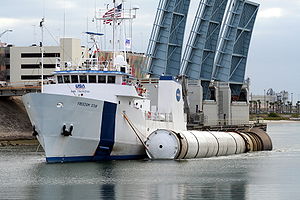MV Freedom Star
 Freedom Star returns to port with an SRB after STS-131 | |
| Career (US) | |
|---|---|
| Name: | MV Freedom Star |
| Owner: | NASA |
| Operator: | United Space Alliance |
| Builder: | Atlantic Marine Shipyard, Fort George Island, near Jacksonville, Florida |
| Launched: | January 1981 |
| Homeport: | Port Canaveral, Florida |
| Status: | In service |
| General characteristics | |
| Length: | 176 feet (53.6 m) |
| Beam: | 37 feet (14.3 m) |
| Draught: | 10-12 feet (3-4 m) |
| Propulsion: |
Two diesel engines providing 2,900 horsepower Two auxiliary engines |
| Boats and landing craft carried: | Two small boats |
| Complement: | nine-person SRB retrieval team, a retrieval supervisor and observers. |
| Crew: | 10 |
| Notes: | Towing capacity: 60,000 pounds (27,000 kg) |
MV Freedom Star is one of two NASA-owned and United Space Alliance operated recovery ships tasked with retrieving spent Solid Rocket Boosters (SRB's) following the launch of Space Shuttle missions and first stage of Ares rockets supporting the Constellation Program. Her sister is the MV Liberty Star.
The ships were built at Atlantic Marine Shipyard on Fort George Island, Florida, and delivered in January 1981 to their original owner, United Towing. As well as recovering the Space Shuttle SRB's Freedom Star has since 1998 been used to tow the Space Shuttle external fuel tanks from their assembly plant at Michoud Assembly Facility in New Orleans, Louisiana to the Vehicle Assembly Building at the Kennedy Space Center in Florida. She served a similar role in recovering the first test flight of the Ares I and was anticipated to continue recovering boosters for the Constellation program before it was canceled in 2010.
The Freedom Star underwent special strengthening enhancements to withstand the greater burden of towing the external fuel tanks. The stern was strengthened at critical points, new bulwark fairings were added, and an H-bitt was installed through which cabling is threaded to keep it centered during towing operations. Also installed was a hydraulic towing winch, referred to as a double-drum waterfall winch, holding 2,000 feet (610 m) or more of wire rope on each drum. One drum supports booster retrievals while the other is devoted to external tank towing.
Freedom Star has also occasionally been used to support scientific research operations including research for the National Oceanic and Atmospheric Administration and several universities. She is usually docked alongside her sister at the Solid Rocket Booster processing facility at the Cape Canaveral Air Force Station in Florida.
Each ship is propelled by two main engines providing a total of 2,900 horsepower. The main engines turn two seven-foot (2.1-meter) propellers with controllable pitch, which provides greater response time and maneuverability. The ships also are equipped with two thrusters. The stern thruster is a water jet system that allows the ship to move in any direction without the use of propellers. This system was installed to protect the endangered manatee population that inhabits regions of the Banana River where the ships are based. The system also allows divers to work near the ship during operations at a greatly reduced risk.[1]
